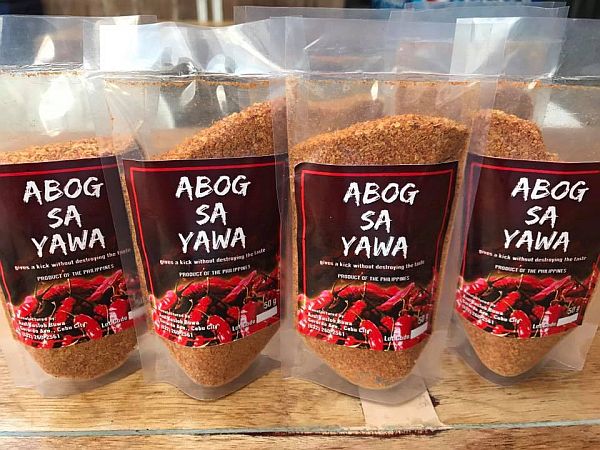
A photo of the chili flakes posted by Sekong last month went viral on Facebook. / contributed photo
Imagine having a cozy candlelit dinner with jazz music playing in the background. A waiter then appears carrying a plate as he gracefully lowers his arm to slide it on the table to serve a dish.
It is a stew of a pig’s brain, peppered with a local brand of chili flakes curiously named “Abog sa Yawa” which in Cebuano means “the devil’s ashes.”
The condiment is a creation of 37-year-old Ian Sekong, a fine arts graduate of the University of San Carlos (USC) who also owns the fancy restaurant Azul in uptown Cebu City.
“In this highly competitive time, it is important to create something original. Be unique so that you can capture people’s attention,” said Sekong.
Sekong told Cebu Daily News that the condiment was given the name to relate its spiciness with the universal concept of hell being extremely hot.
Defending the brand before the Intellectual Property Organization (IPO) was a rough obstacle that Sekong and his team of lawyers needed to hurdle as IPO, he said, tried to ban the use of the Cebuano word for devil which is generally considered a bad word when used as an expression.
“The IPO tried to ban it and suggested another name. But I stayed firm and our team of lawyers managed to defend that … there was no written history, no binding document, to prove as to why the word ’yawa’ is considered as a cuss,” he said.
A photo of his chili flakes went viral on Facebook last August, garnering 10,000 likes and at least 2,000 shares.
How it all began
Abog sa Yawa started as a simple condiment in Azul Restaurant when it introduced an upscale version of tuslob-buwa, a variety of Cebuano street food made of pig’s brain which has grown popular among the masses.
Tuslob-buwa, whose origins can be traced to Barangay Pasil, Cebu City, literally translates to “dip in bubbles” as customers dip “puso” or hanging rice in a boiling stew of pig’s brain.
Unlike the stew sold in the narrow streets of Pasil, Azul customers get to cook the exotic food themselves in the comforts of the restaurant.
To add more flavor to the stew, a variety of ingredients such as shrimp paste, white onions, garlic and fish sauce (patis) are offered.
For those who want their dish spicy, Sekong concocted abog sa yawa as an alternative to hot sauce which usually numbs the taste buds due to its spiciness.
Consisting of three kinds of chili peppers — kulikot, labuyo and Scotch Bonnet planted by farmers in Sibonga, Argao, San Fernando and Carcar City — the spices are dried and crushed until they turn into a fine, red-orange powdery substance.
“That’s when I got the idea to sell it because the days after we first introduced it as an additional ingredient, more and more people are asking whether we are selling the chili flakes,” Sekong said.
The condiment, which sells at P50, became an instant hit, and within two days, all of the 200 packs that made up the first batch were sold out, said Sekong.
Sekong did not hesitate to travel more than 50 kilometers south of Cebu City to learn more about Scotch Bonnet, a type of chili grown originally in the Caribbeans.
“Indeed, there were quite a few farmers who started to plant Scotch Bonnet in their own lands. So I bought some, took them back to Cebu City and planted them in my own backyard,” he said.
The spiciness of Scotch Bonnet is a notch higher than the native wild chilis, kulikot and labuyo, he noted.
Aside from using his creativity to combine all three spices to make a special chili brand, through his creations, Sekong aimed to bridge the gap between the different socioeconomic classes.
“I want the rich people who usually irk (sic) towards exotic food to taste them without having to undergo uncomfortable experiences. And I want the poor to be empowered by showcasing to everyone their uniqueness and creativity in cooking,” Sekong said.